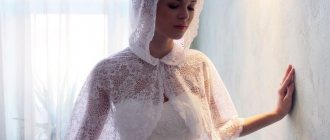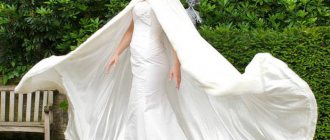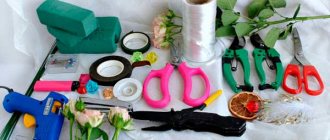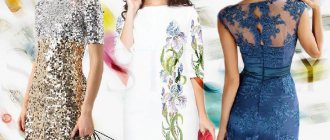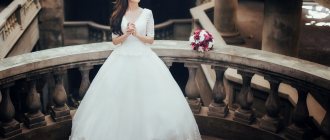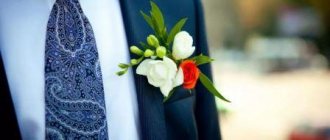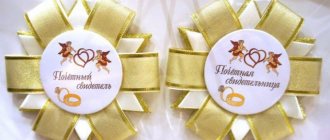When visiting a temple, every woman should be dressed appropriately. In particular, you need to pay attention to the headdress - women should only enter the Orthodox Church with their heads covered. For these purposes, they often use a light chiffon scarf or a regular scarf, however, if you are a believer and pay attention to this, we recommend sewing a simple flowing scarf for the temple yourself. Its pattern is offered below. To make a scarf you will need a minimum of time and materials, and the result will exceed all expectations!;)
What fabric is suitable for a temple scarf?
To create a flowing scarf, any light, breathable fabric is suitable. We recommend paying attention to the following options:
- guipure;
- silk,
- satin;
- organza;
- scalloped lace fabric.
It is not recommended to select fabrics that are too transparent, since, according to generally accepted standards, a woman in a temple should look modest and discreet. An exception is weddings: scarves made from thin, translucent materials are allowed here.
It is important to remember that the hood should cover the head and not be worn on it like a hat. In addition, the chest and shoulders should also be covered.
History of the church scarf
The tradition of covering our heads came to us from antiquity, and not only ancient times. The headband was a common accessory for both Viking and Slav wives of the pagan era. Greek and Roman women, like women of the East, did not wear scarves, but spacious bedspreads that hid their figures to the toes. Such clothing protected both from the scorching sun and from immodest glances. This is how the custom inherited by the church was established.
Reference : the first mention of a scarf is contained in ancient Egyptian manuscripts describing a quadrangular piece of fabric covering the shoulders.
The Apostle Paul finally ordered Christian women to wear a head covering, and not only in church.
For a long time, married Christian women, Catholics and Orthodox, could not appear in public without a rather strict headdress, hiding not only their hair, but also their forehead and neck. Girls were often freer in this matter, but not on the church grounds: they did not go there with their heads uncovered. They don't go now.
Traditionally, parishioners wear headscarves, although there are no clear regulations regarding headwear . It's a matter of taste. In the case of a church scarf, it is often very elegant. After all, a woman’s head covered with thin (often lace) fabric looks touching and exciting! And without any violations of the rules of piety. Especially if we are talking about the Don scarf, which resembles a hood.
The history of its appearance has not even celebrated its tenth anniversary, having begun in 2010 on the Don.
Reference . The flowing scarf was created by Irina Potapova, a woman in whose life, thanks to her diligent prayers, a small miracle happened. She became a mother, contrary to the pessimistic predictions of doctors.
Preparing for Epiphany, she sought to create a joyful and bright festive atmosphere. This is how a real design miracle appeared - you can be elegant without violating the rules of piety!
How to choose the color of the cape
It is extremely important to choose the right color of the cape-hood for the temple.
The white color symbolizes the miraculous light of God. It is appropriate for weddings, Christmas, Epiphany, Ascension and Transfiguration. A white cape is also worn for Easter services and the sacrament of baptism.
The black color of the scarf is the complete opposite of white. Such a headdress should be worn for repentance, renunciation of temptations, during fasting or mourning.
Colored capes can also be appropriate. For example, green - on Trinity, blue - on the days of veneration of the Mother of God.
What is a wedding scarf?
Girls who are committed to the classics choose a multi-layered fluffy veil. Romantic young ladies and desperate dreamers decorate their heads with wreaths of ribbons and fresh flowers. And Orthodox brides often appear before the altar in wedding capes with a hood. And I must say, they are not making a mistake at all! There are at least three reasons to try on an unusual accessory:
It is beautiful. Weightless lace fabric, falling in folds from the head and shoulders, will add another bright, and at the same time delicate touch to your outfit, helping you look cute, spiritual and a little mysterious. This is original. Of the five brides, three go to the altar wearing the same veil, so the cape will definitely make the newlywed’s appearance interesting and memorable. Even if three or more couples are getting married in the church, you won’t be able to get lost among them. This corresponds to church canons. Orthodox tradition requires a woman to cover her head in church. At the same time, it is believed that the newlywed’s face should remain completely open during the wedding. A veil in this case is not the best choice, since it is often attached to the back of the head, without covering the top of the head, or has several tiers, one of which the bride drapes over her forehead before entering the temple. The cape will allow you to comply with the principles without sinning against the beauty of the newlywed. And even choose a dress with a neckline and open shoulders! It’s not appropriate to appear in church like this, but a wedding scarf will solve this problem in an instant, masking all the “liberties” with its wide folds.
How to sew a scarf for a temple with your own hands: master class
First, cut off the required amount of fabric for sewing the cape. Next, you need to fold the resulting segment in half and mark it as shown in the diagram. The dotted line marks the place where the drawstring will be sewn in; below (20 and 30 cm) there is a cape, which, falling, will cover the shoulders and chest. The cape gradually lengthens - from the chest to the center of the back. If desired, it can be lengthened or shortened. Having transferred all the lines to the fabric, we cut it out, not forgetting about the seam allowances.
There are two ways to sew a cape
The first method is simple, without a drawstring. In this case, we will need to carefully bend the edges by 2-3 millimeters and sew them on a typewriter, and run the lace prepared in advance along the bottom.
The second method is more difficult. We sew the drawstring from the wrong side along the marked line and stretch a satin ribbon or braid into it to match the cape, 50-70 cm long.
How to decorate a finished cape
A scarf sewn according to our master class is suitable for both everyday church services and holidays. It is important to remember that the Orthodox Church does not approve of jewelry, so it is important not to overdo it either with the brightness of the color of the product or with its decor. You can decorate such a cape with a small brooch or beads/beads along the bottom of the product.
How to wear a Don scarf correctly
Sewn specifically for visiting church, the scarf should cover the head and shoulders, falling slightly onto the forehead and cheeks.
If it is properly sewn and worn accordingly, it covers its wearer. A scarf that is kept haphazardly on the top of the head does not comply with the rules.
Having left the temple, you can freely place the upper part of the scarf over your shoulders, as if with a folded hood. This will give the look elegance and sophistication.
What to wear with blue shoes
What is an anorak
Benefits of a head cap
The cape is not just beauty and a tribute to Orthodox traditions. This accessory is quite practical and convenient. In the winter season, a correctly selected piece of clothing made of dense material will warm you up; in the summer season, it will correct the too open style of the dress.
In church, girls are prohibited from appearing with open arms and cleavage.
But this does not mean that you will have to give up a dress with a deep neckline, and in the summer swelter from the heat in a dress with long sleeves. A lace bolero or poncho with a hood will come to the rescue.
Important!
In bad weather, the hood will not only warm the bride, but also protect her hair. At the banquet the young wife will look impeccable.
Types of hats
Most often, brides prefer the white color of the accessory or its more delicate shades - ivory, champagne, cream. However, the Orthodox Church allows other colors, the main thing is that they are light, gentle, pastel. Bright or dark variations - cherry, black, purple - are best left for another holiday.
Materials: lace, satin, silk
As for the fabric, lace looks great. Delicate openwork patterns framing the bride's face will emphasize her charm and innocence. Carefully match your scarf to your lace dress. The patterns should match or at least overlap, but not conflict, otherwise the image will turn out sloppy. Delicate satin or silk, airy tulle, chiffon, and organza look no worse as a material for a scarf. It is acceptable to decorate your headdress with embroidery, rhinestones, and braid, but remember moderation. The image should not be flashy.
Styles: bonnet, bolero, cloak
There are a great variety of styles of wedding scarves.
A very gentle option is a bolero with a hood, fastened with elegant buttons. It will wonderfully hide overly exposed shoulders or neckline and add romance, femininity and innocence to the image.
A more closed option is a cloak that covers the head and falls down to the very hem or even flows into a train. Suitable for both the most conservative prudes and girls who would like to feel like a real princess at their wedding.
If you have a chaste closed dress, then you can choose an open option - a stole that covers only your hair. Usually this accessory is made of weightless lace, but other options are possible.
The simplest solution is a headscarf tied at the back or front. A modest, elegant accessory will emphasize the solemnity of the moment, will not cause indignation in those present and will not distract attention from the natural beauty of the bride.
Fastenings on a scarf can be in the form of buttons, or they can be ties, hooks or buttons. And if you choose a model with a hood, then you won’t have to secure it in any way at all - except maybe attach it to your hair with bobby pins.
Pros of models with a hood
Newlyweds choose hooded accessories for weddings for several reasons:
- Aesthetics
– the cape adds femininity and innocence to the bride’s image. This element of clothing makes any representative of the fair sex especially attractive and mysterious; - Compliance with church canons.
- a special rite that believers go through. All traditions are observed in the temple, including those relating to appearance and choice of clothing. A wedding bolero will help you comply with church canons and at the same time look attractive and luxurious; - Originality
- modern brides believe that a veil is too traditional and even a banal element of clothing. Many people refuse this accessory in favor of capes.
Choosing a stole for a dress
You can buy a wedding cape in a store or sew it yourself. When choosing an accessory for a church ceremony, it is important to ensure that it matches the bride’s outfit. This is especially true for the color scheme.
The traditional color of a wedding dress is white. It symbolizes purity and lightness. A white dress gives a special charm to the future wife. It is best to choose a cape of the same color.
Those who want to stand out choose an accessory in a contrasting color. Blue or gray capes are completely acceptable. But in this case, you should pay attention to additional accessories. They must match the color scheme of the entire image.
When choosing a cape for a wedding, you should take into account that the hood should be quite spacious
so as not to hinder the bride’s movements and not disturb. And some more useful tips:
- Bolero is suitable for warm seasons and dresses with open arms, neckline and open back
; - A poncho will help hide too much neckline;
- A cape-hood suits better than others;
- Brides who want to highlight their graceful figure and maximize the beauty of their dress will love the bolero;
- If the top of the dress is decorated with voluminous details, then it is better to opt for a modest bolero with one hook clasp;
- A maximally closed cape with long sleeves looks great with a tight-fitting dress;
- A short bolero, a hip-length cape or even a cape will suit a tight-fitting skirt.
Types and styles of capes
It all depends on your taste, wishes and cut of the wedding dress.
A bolero fastened with several buttons or hooks with lace sleeves and a hood is suitable not only for brides who choose a revealing neckline, but also for girls in elegant, tight-fitting dresses without unnecessary details on the bodice. In this case, a closed cape will complete the look.
If the bodice of the wedding dress is decorated with complex embroidery, beads or artificial flowers, you should opt for models that are completely open or have only one clasp.
Romantic brides will appreciate the voluminous “cloak”, the length of which can reach the floor. Those who prefer simplicity and conciseness to all refinements will love the cape-scarf with a drawstring and satin ties.
...And natural seamstresses and simple handymen can easily build a wedding cape with a hood with their own hands.
